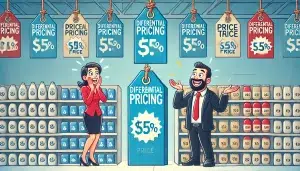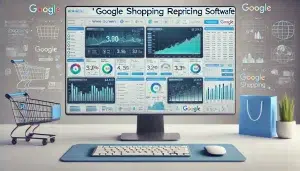
Table of Contents
- Introduction
- Understanding Price Optimization
- The Importance of Price Optimization
- Key Components of Price Optimization
- Price Optimization Strategies
- Implementing Price Optimization
- Challenges in Price Optimization
- Price Optimization Tools and Software
- Real-World Examples
- My Experience with Price Optimization
- How Pricefy Can Help with Price Optimization
- Conclusion
- FAQs
- Useful Links
Introduction
Price optimization is the strategic process of determining the most effective pricing for products or services to maximize profitability while considering market conditions, customer behavior, and competitive factors. It’s like finding the sweet spot where your customers are happy to pay, and you’re thrilled to sell – a win-win situation that’ll make your wallet do a happy dance!
Understanding Price Optimization
What Exactly is Price Optimization?
Price optimization is a data-driven approach that combines market analysis, customer insights, and advanced algorithms to set the ideal price point for goods or services. It’s not just about slapping a price tag on something and hoping for the best – it’s a sophisticated balancing act that takes into account various factors to maximize revenue and profitability.
The Science Behind the Price Tag
At its core, price optimization relies on the economic principle of price elasticity, which measures how sensitive demand is to price changes. It’s like stretching a rubber band – some products snap back quickly when you change the price, while others barely budge.
Why It’s Not Just About Lowering Prices

Contrary to popular belief, price optimization isn’t about racing to the bottom. It’s about finding the optimal price that aligns with your business goals, customer perceptions, and market position. Sometimes, the right move is to raise prices – shocking, I know!
The Importance of Price Optimization
In today’s cutthroat market, price optimization is more critical than ever. Here’s why it’s a game-changer:
- Maximized Profitability: By finding the sweet spot between cost and perceived value, you can boost your bottom line.
- Improved Competitiveness: Stay one step ahead of the competition by dynamically adjusting prices.
- Enhanced Customer Satisfaction: Offer fair prices that align with customer expectations and willingness to pay.
- Data-Driven Decision Making: Base pricing decisions on solid data rather than gut feelings or guesswork.
- Increased Market Share: Capture more customers by offering attractive prices without sacrificing profits.
The Impact on Your Bottom Line

Studies have shown that effective price optimization can increase profits by 3-8% for every 1% improvement in pricing. That’s not just pocket change – it’s a potential goldmine!
Key Components of Price Optimization
To master the art of price optimization, you need to understand its key components:
1. Data Collection and Analysis
Gather and analyze relevant data, including:
- Historical sales data
- Competitor pricing
- Customer behavior and preferences
- Market trends
2. Segmentation
Divide your market into distinct groups based on factors like:
- Demographics
- Purchasing power
- Buying behavior
- Geographic location
3. Price Elasticity Modeling
Develop models to understand how price changes affect demand for different products or customer segments.
4. Competitive Analysis
Keep a close eye on your competitors’ pricing strategies and market positioning.
5. Dynamic Pricing Capabilities
Implement systems that allow for real-time price adjustments based on market conditions and demand.
Price Optimization Strategies

Now that we’ve got the basics down, let’s dive into some killer strategies to optimize your pricing:
- Value-Based Pricing: Set prices based on the perceived value to the customer, not just your costs.
- Dynamic Pricing: Adjust prices in real-time based on demand, supply, and other market factors.
- Bundling: Offer product bundles at attractive prices to increase overall sales and customer value.
- Psychological Pricing: Use pricing techniques that appeal to customer psychology, like charm pricing (e.g., $9.99 instead of $10).
- Tiered Pricing: Offer different price points for various levels of products or services to cater to different customer segments.
Remember, the key is to find the strategy that works best for your business and customer base. It’s not one-size-fits-all – it’s more like finding the perfect pair of jeans that make your business look fabulous!
Implementing Price Optimization
Ready to take the plunge into price optimization? Here’s a step-by-step guide to get you started:
- Assess Your Current Pricing Strategy: Take a hard look at your existing pricing methods and identify areas for improvement.
- Gather and Analyze Data: Collect relevant data on costs, sales, customer behavior, and market trends.
- Define Your Objectives: Set clear goals for your price optimization efforts, such as increasing profitability or market share.
- Choose Your Optimization Method: Select the appropriate pricing strategy based on your business model and objectives.
- Implement Price Changes: Roll out your new pricing strategy, starting with a pilot if possible.
- Monitor and Adjust: Continuously track the results of your price changes and make adjustments as needed.
- Invest in Technology: Consider implementing price optimization software to automate and streamline the process.
- Train Your Team: Ensure your sales and marketing teams understand and can effectively communicate the new pricing strategy.
Remember, Rome wasn’t built in a day, and neither is a perfect pricing strategy. Be patient, stay flexible, and keep refining your approach.
Challenges in Price Optimization

While price optimization can be a powerful tool, it’s not without its hurdles. Here are some common challenges you might face:
- Data Quality and Availability: Garbage in, garbage out – ensure you have access to accurate and comprehensive data.
- Resistance to Change: Employees and customers may resist new pricing strategies. Clear communication is key.
- Technological Limitations: Implementing sophisticated price optimization systems can be complex and costly.
- Balancing Short-term and Long-term Goals: Don’t sacrifice long-term customer relationships for short-term gains.
- Regulatory Compliance: Ensure your pricing practices comply with all relevant laws and regulations.
Don’t let these challenges scare you off – with the right approach and tools, you can overcome them and reap the rewards of effective price optimization.
Price Optimization Tools and Software
In today’s digital age, there’s no need to crunch numbers on an abacus. Here are some top-notch tools to supercharge your price optimization efforts:
- Pricefy: A comprehensive pricing platform that offers advanced analytics and dynamic pricing capabilities.
- IntelligenceNode: Focuses on SaaS businesses, providing pricing strategy and optimization services.
- Competera: Offers competitive pricing and market analysis tools for e-commerce businesses.
- Pricefx: A cloud-based price optimization and management platform for various industries.
These tools can help you automate your pricing processes, gain valuable insights, and stay ahead of the competition. It’s like having a pricing superhero on your team!
Real-World Examples

Let’s take a look at some companies that have mastered the art of price optimization:
- Amazon: The e-commerce giant uses dynamic pricing to adjust prices on millions of products multiple times per day.
- Netflix: Utilizes tiered pricing to cater to different customer segments and maximize subscriber base.
- Walmart: Employs a combination of everyday low pricing and dynamic pricing to stay competitive in the retail space.
These companies have turned price optimization into an art form, proving that with the right strategy, you can achieve remarkable results.
My Experience with Price Optimization
As a pricing strategist, I’ve seen firsthand the transformative power of price optimization. I once worked with a struggling e-commerce company that was constantly undercut by competitors. By implementing a dynamic pricing strategy and segmenting their customer base, we were able to increase their profit margins by 15% in just six months.
The key lesson? Don’t be afraid to experiment and iterate. Price optimization is an ongoing process, not a one-time fix. Stay curious, keep learning, and always be ready to adapt to changing market conditions.
How Pricefy Can Help with Price Optimization
Pricefy is a game-changer when it comes to price optimization. This powerful platform offers a suite of tools designed to take your pricing strategy to the next level:
- Advanced Analytics: Gain deep insights into your pricing data and market trends.
- Dynamic Pricing Engine: Automatically adjust prices based on real-time market conditions.
- Competitor Monitoring: Keep tabs on your competitors’ pricing strategies.
- Segmentation Tools: Easily divide your customer base for targeted pricing strategies.
- A/B Testing: Experiment with different pricing strategies to find what works best.
With Pricefy, you’re not just optimizing prices – you’re optimizing your entire business strategy. It’s like having a crystal ball for pricing, minus the smoke and mirrors!
Conclusion
Price optimization it’s a powerful strategy that can revolutionize your business. By leveraging data, understanding your market, and implementing the right tools and techniques, you can find that pricing sweet spot that keeps both your customers and your bottom line happy.
Remember, price optimization is an ongoing journey, not a destination. Stay curious, keep experimenting, and don’t be afraid to shake things up. After all, in the world of pricing, fortune favors the bold!
FAQs
- What does a price optimization specialist do?
A price optimization specialist analyzes market data, customer behavior, and competitive landscapes to determine the most effective pricing strategies for products or services. They use advanced analytics and modeling techniques to maximize profitability while maintaining customer satisfaction. - How is price optimization done?
Price optimization is typically done through a combination of data analysis, market research, and predictive modeling. It involves collecting relevant data, segmenting customers, analyzing price elasticity, and using sophisticated algorithms to determine optimal price points. - What does optimal pricing mean?
Optimal pricing refers to setting prices at a level that maximizes profitability while considering factors such as customer demand, production costs, and competitive pressures. It’s about finding the balance between attracting customers and maximizing revenue. - What is the optimal pricing rule?
The optimal pricing rule states that the price should be set where marginal revenue equals marginal cost. In simpler terms, it means pricing a product so that the additional revenue from selling one more unit equals the additional cost of producing that unit. - What is an optimized pricing decision called?
An optimized pricing decision is often referred to as “dynamic pricing” or “algorithmic pricing.” These terms describe the process of using data and algorithms to set prices that respond to market conditions in real-time. - What is the optimal price theory?
Optimal price theory suggests that there’s an ideal price point for every product or service that maximizes profitability. This theory takes into account factors like price elasticity of demand, competitor pricing, and production costs to determine the most profitable price. - What is the first best pricing rule?
The first best pricing rule, also known as the marginal cost pricing rule, states that in a perfectly competitive market, the optimal price is equal to the marginal cost of production. However, this rule is often difficult to apply in real-world scenarios due to market imperfections. - What is the optimum pricing formula?
There’s no one-size-fits-all optimum pricing formula, as it depends on various factors specific to each business and market. However, a general formula might look like: Optimal Price = (Unit Cost) / (1 – Desired Profit Margin). - What is the rule of 3 pricing?
The rule of 3 pricing, also known as tiered pricing, involves offering three different price points for a product or service. This strategy caters to different customer segments and can help increase overall sales and profitability. - How do you optimize product cost?
Product cost optimization involves strategies like improving operational efficiency, negotiating better deals with suppliers, reducing waste, and implementing lean manufacturing practices. It’s about finding ways to reduce costs without compromising quality. - What are the stages of cost optimization?
The stages of cost optimization typically include:- Analyzing current costs
- Identifying areas for improvement
- Developing cost-saving strategies
- Implementing changes
- Monitoring results
- Continuous improvement
- What is the target of cost optimization?
The primary target of cost optimization is to reduce expenses while maintaining or improving the quality of products or services. The ultimate goal is to increase profitability and competitiveness. - How do you optimize cost per order?
To optimize cost per order, businesses can:- Streamline order processing
- Reduce packaging costs
- Optimize inventory management
- Improve supply chain efficiency
- Implement automation where possible
- How do you optimize cost to serve?
Optimizing cost to serve involves analyzing and improving all aspects of customer service delivery. This can include streamlining processes, implementing self-service options, optimizing resource allocation, and leveraging technology to reduce costs while maintaining customer satisfaction. - How do you optimize the purchasing process?
To optimize the purchasing process:- Centralize purchasing operations
- Implement e-procurement systems
- Negotiate volume discounts with suppliers
- Regularly review and update supplier contracts
- Analyze spending patterns to identify cost-saving opportunities
- What are 3 basic pricing strategies?
The three basic pricing strategies are:- Cost-plus pricing: Adding a markup to the cost of goods
- Competition-based pricing: Setting prices based on competitors
- Value-based pricing: Pricing based on perceived value to the customer
- What are the 4 steps to pricing strategy?
The four steps to developing a pricing strategy are:- Determine your business goals
- Conduct market research and competitor analysis
- Calculate your costs and desired profit margins
- Choose and implement a pricing strategy
- What are the 3 C’s of pricing?
The 3 C’s of pricing are:- Costs: Understanding your production and operational costs
- Customers: Knowing your target market and their willingness to pay
- Competition: Analyzing competitor pricing and market positioning
- What are the 3 P’s of pricing?
The 3 P’s of pricing are:- Price: The actual amount charged for a product or service
- Placement: Where and how the product is sold
- Promotion: How the price is communicated to customers
- What is the simplest pricing strategy?
The simplest pricing strategy is cost-plus pricing, where a fixed percentage is added to the cost of goods to determine the selling price. While simple, this method doesn’t account for market conditions or customer perceptions.
Useful Links
- Harvard Business Review: A Quick Guide to Value-Based Pricing
- McKinsey & Company: Pricing in a Pandemic: Navigating the COVID-19 Crisis
- MIT Sloan Management Review: Is It Time to Rethink Your Pricing Strategy?
- Deloitte: Pricing and Profitability Management
- Forbes: How to optimize your pricing strategy
- PricingBrew Journal: The real meaning of price optimization
And there you have it, folks! A deep dive into the world of price optimization that’s sure to make your wallet do the cha-cha.
Now, if you’ll excuse me, I’m off to optimize the price of my time – these witty pricing puns don’t write themselves, you know!




